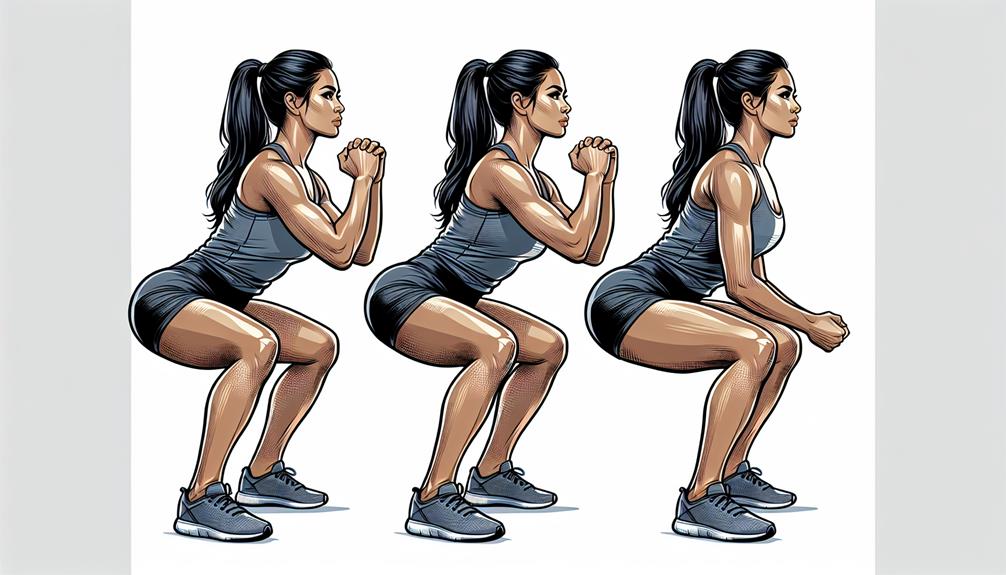Did you know that only 23% of adults in the United States meet the recommended guidelines for physical activity? If you're a beginner looking to start your fitness journey, mastering the basics is crucial. But where do you begin? In this essential exercise guide for beginners, we will take you through a step-by-step process, covering warm-up exercises, upper body workouts, lower body workouts, core strengthening exercises, and flexibility and mobility exercises. Whether you're looking to improve your overall fitness, lose weight, or simply lead a healthier lifestyle, this guide will provide you with the foundation you need to get started. So, let's dive in and discover the key exercises that will help you achieve your fitness goals.
Key Takeaways
- Warm-up exercises are important to prepare muscles and joints for physical activity and prevent injury.
- Upper body workouts should include exercises like dumbbell curls, push-up variations, rows, and planks to strengthen and tone the upper body.
- Lower body workouts should focus on squat variations, engaging multiple muscle groups, and using equipment like the leg press machine.
- Core strengthening exercises like planks, bicycle crunches, Russian twists, and dead bug exercises are essential for building core strength.
Warm-Up Exercises
Before you begin your workout, it is essential to incorporate warm-up exercises to prepare your muscles and joints for the physical activity ahead. Proper form during warm-up exercises is of utmost importance to prevent injury and optimize performance. Whether you are about to engage in cardiovascular exercises, strength training, or flexibility workouts, there are effective warm-up routines tailored to each type of workout.
For cardiovascular exercises such as running or cycling, start with five to ten minutes of low-intensity aerobic movements like brisk walking or light jogging. This increases your heart rate gradually and warms up your muscles. Follow it up with dynamic stretches targeting major muscle groups, such as leg swings or arm circles, to improve flexibility and range of motion.
Strength training warm-ups involve performing lighter versions of the exercises you plan to do. For example, if you are going to do squats with weights, start with bodyweight squats to activate the muscles and increase blood flow. Additionally, incorporate mobility exercises like shoulder rotations or hip circles to mobilize the joints and prepare them for the upcoming load.
For flexibility workouts like yoga or Pilates, include dynamic stretches that focus on the areas you will be working on. For instance, if you are going to do a lot of leg stretches, perform leg swings or standing hamstring curls to warm up those muscles.
Upper Body Workouts
To target and strengthen your upper body, incorporate these effective workouts into your fitness routine. Start with dumbbell exercises, such as bicep curls, shoulder presses, and tricep kickbacks. These exercises engage your arms, shoulders, and back muscles, helping to build strength and definition. Remember to start with lighter weights and gradually increase as your strength improves.
Next, try different push-up variations to target your chest, shoulders, and triceps. Standard push-ups are a great starting point, but you can also try incline push-ups, decline push-ups, or diamond push-ups for added challenge. These variations allow you to target different muscle groups within your upper body, ensuring a well-rounded workout.
In addition to dumbbell exercises and push-up variations, don't forget to incorporate exercises that target your upper back and core. Rows, pull-ups, and planks are excellent choices for strengthening these areas.
To maximize the effectiveness of your upper body workouts, aim to perform two to three sets of each exercise, with 10 to 15 repetitions per set. Remember to maintain proper form throughout each exercise and take rest days to allow your muscles to recover.
Lower Body Workouts

Looking to strengthen and tone your lower body? Incorporating lower body workouts into your exercise routine is essential for building strength and achieving a balanced physique. Two key exercises that target the lower body are squat variations and the leg press technique.
Squats variations are a versatile exercise that engages multiple muscle groups in the lower body, including the quadriceps, hamstrings, glutes, and calves. They can be performed using body weight or with added resistance such as dumbbells or barbells. Some popular squat variations include goblet squats, sumo squats, and Bulgarian split squats. By incorporating different squat variations into your routine, you can challenge your muscles in new ways and prevent plateaus.
The leg press machine is another effective exercise for targeting the lower body. To perform the leg press, sit in the machine with your back against the pad and your feet on the platform. Push the platform away from your body by extending your knees until your legs are straight. Slowly lower the platform back down to the starting position. Adjust the weight and foot placement to target different muscle groups within the lower body.
Core Strengthening Exercises
For a strong and stable core, incorporating core strengthening exercises into your routine is essential. Your core muscles play a crucial role in supporting your spine, improving posture, and enhancing overall fitness. Here are four effective core exercises for beginners:
- Plank: Start by getting into a push-up position, resting your weight on your forearms. Keep your body in a straight line from head to toe, engaging your core muscles. Hold this position for 30 seconds to 1 minute, gradually increasing the duration as you get stronger.
- Bicycle Crunches: Lie on your back with your knees bent and your hands behind your head. Lift your shoulders off the ground and bring your right elbow towards your left knee, while extending your right leg. Repeat on the other side in a cycling motion. Aim for 10-15 repetitions on each side.
- Russian Twists: Sit on the floor with your knees bent and your feet flat on the ground. Lean back slightly while maintaining a straight spine. Hold a weight or a medicine ball with both hands and twist your torso from side to side, touching the weight to the ground on each side. Aim for 10-15 repetitions on each side.
- Dead Bug: Lie on your back with your arms extended towards the ceiling and your knees bent at a 90-degree angle. Slowly lower your right arm and left leg towards the ground while keeping your core engaged. Return to the starting position and repeat on the other side. Aim for 10-12 repetitions on each side.
Incorporating these core exercises into your routine will help you build a strong and stable core, improving your overall fitness and enhancing your performance in other exercises and daily activities.
Flexibility and Mobility Exercises

Now that you have strengthened your core with effective exercises, let's focus on improving your flexibility and mobility. Flexibility is an important aspect of fitness that allows you to move your joints through their full range of motion. It helps prevent injuries, improves posture, and enhances performance in other exercises and activities. Incorporating stretching routines and joint mobility exercises into your workout routine can greatly improve your flexibility and mobility.
Here is a table outlining some stretching routines and joint mobility exercises that you can incorporate into your fitness regimen:
| Stretching Routines | Joint Mobility Exercises |
|---|---|
| Hamstring stretch | Shoulder circles |
| Quadriceps stretch | Wrist circles |
| Chest stretch | Ankle rotations |
Stretching routines involve holding a stretch for a certain amount of time to increase the length of your muscles and improve flexibility. Joint mobility exercises, on the other hand, focus on moving your joints through their full range of motion to improve mobility and reduce stiffness. Incorporating both stretching routines and joint mobility exercises into your workout routine can help you achieve optimal flexibility and mobility.
Remember to warm up before performing these exercises and consult with a fitness professional if you have any pre-existing conditions or injuries. Start slowly and gradually increase the intensity and duration of your stretches and joint mobility exercises over time. With consistent practice, you will notice improvements in your flexibility and mobility, allowing you to move more freely and perform exercises with better form.
Frequently Asked Questions
How Do I Choose the Right Workout Routine for My Fitness Goals and Body Type?
To choose the right workout routine for your fitness goals and body type, consider your objectives and what exercises align with them. Also, take into account your body type and what types of workouts are best suited for you.
What Are the Best Exercises for Improving Posture and Preventing Back Pain?
To improve your posture and prevent back pain, focus on exercises that strengthen your core and back muscles. Incorporate exercises like planks, deadlifts, and rows into your routine. Remember, "practice makes perfect."
How Often Should I Change My Workout Routine to Continue Seeing Progress?
To continue seeing progress, it's important to maintain workout routine consistency. However, changing your routine too often can hinder progress. Optimal frequency for workout routine changes varies, but a general guideline is every 4-6 weeks.
Are There Any Specific Exercises I Should Avoid if I Have a Previous Injury or a Medical Condition?
If you have a previous injury or medical condition, it's important to be cautious with certain exercises. For knee injuries, focus on low-impact activities like swimming or cycling. Modify exercises to suit your needs and always listen to your body.
What Are Some Tips for Staying Motivated and Consistent With My Exercise Routine?
To stay motivated and consistent with your exercise routine, set specific goals, track your progress, find a workout buddy, mix up your exercises, reward yourself, and overcome plateaus by challenging yourself with new workouts.
Conclusion
In conclusion, mastering the basics of exercise is essential for beginners. By incorporating warm-up exercises, upper and lower body workouts, core strengthening exercises, and flexibility and mobility exercises into your routine, you can build a solid foundation for your fitness journey. Remember, Rome wasn't built in a day, so take it one step at a time and gradually increase the intensity of your workouts. With patience and consistency, you'll soon be on your way to achieving your fitness goals. Keep up the good work!













